Lake Clark National Park
My wife Becky and I visited Silver Salmon Creek Lodge within the Lake Clark National Park during mid-September 2021 for a week. Our goal was to photograph coastal brown bears in a natural environment. Our trip was timed to catch the end of the salmon run on Silver Salmon Creek. Lake Clark National Park is about 4 million acres and is located on the western side of the Cook Inlet in southern Alaska. The park contains 2 active volcanoes (Mount Iliamna and Mount Redoubt) and some incredible wilderness scenery.
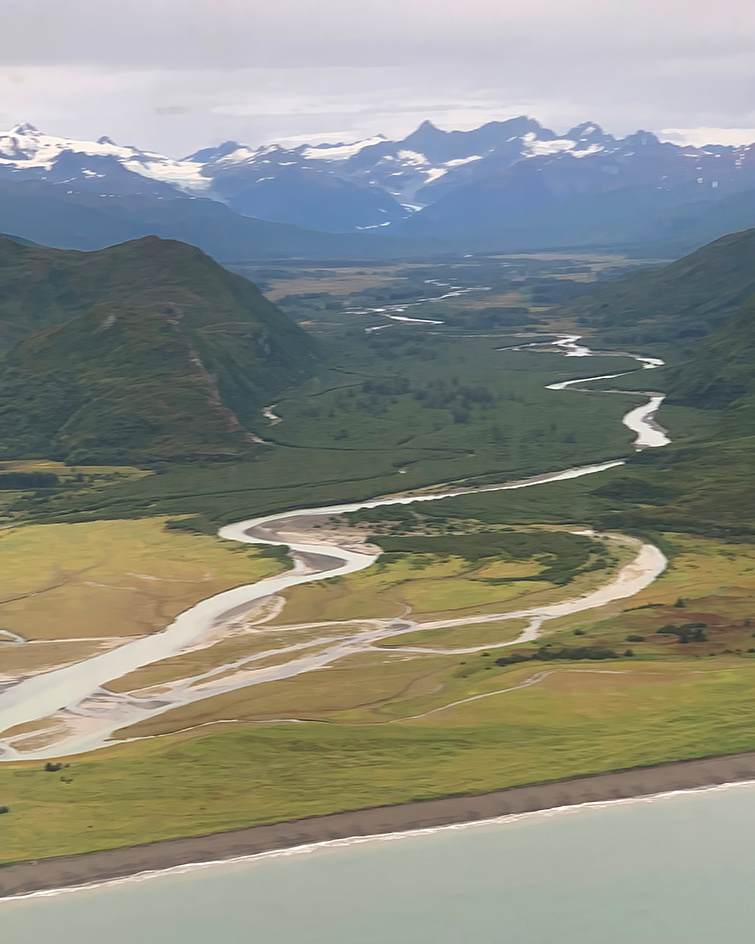

The Johnson Creek watershed which forms the northern boundary of the area worked by the lodge. (I-Phone photo from the plane. Courtesy of Becky Bogener)
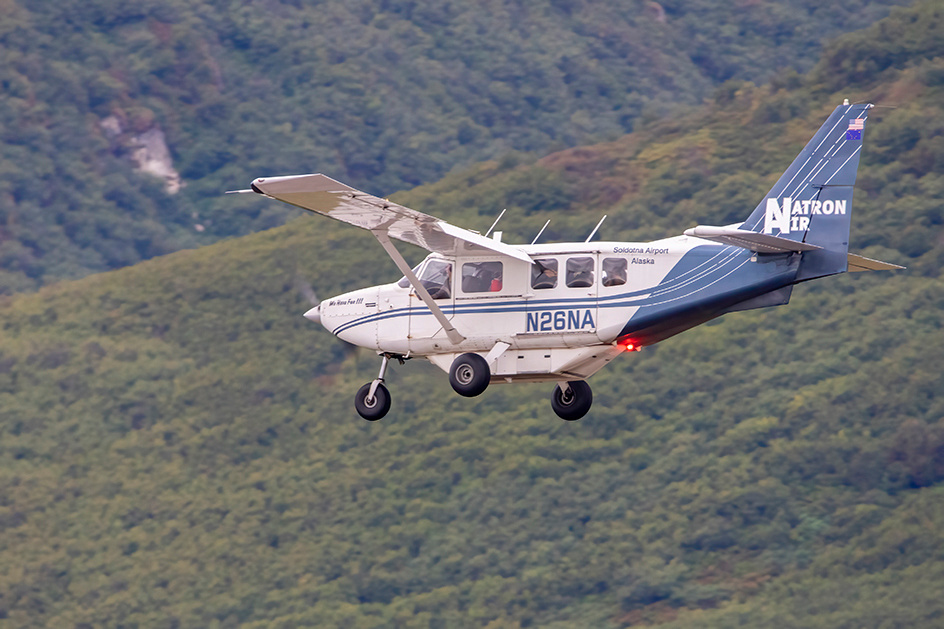

We flew on Alaska Airlines from Redding to Anchorage and rented a car for the scenic 3 hour drive to Soldatna. The next morning we flew on an Australian bush plane from Soldatna to the lodge. Our pilot Tim, brought us in for a very smooth landing on the beach during low tide. We were met on the beach by Oliver Coray, the owner's son. Oliver helped us unload and quickly reloaded outgoing passengers who immediately took off. We were transported to the lodge in custom-made aluminum carts pulled by Honda ATVs. Note the lack of suspension on the carts.


We observed two bears from the plane while landing and were more than ready to get the photo gear unpacked. Wolf and bear tracks were present on the beach.
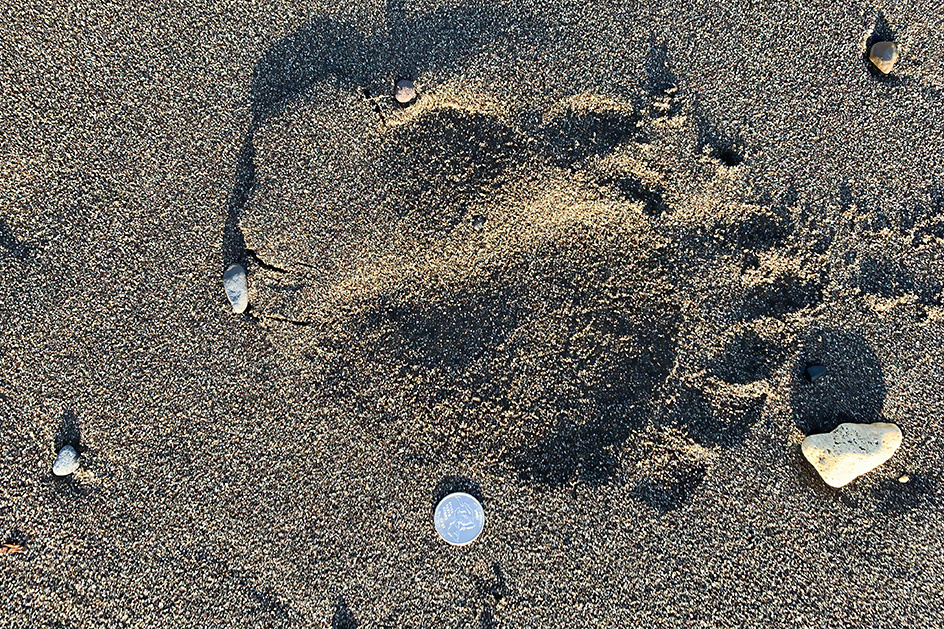

Bear Tracks
We unpacked quickly and were provided with rubber knee boots and a brief safety discussion from our guide Rob. We immediately headed for the bears we had seen from the air which were being closely followed by a group of photographers. We immediately discovered that the bears were very acclimated to close human presence. For most photo opportunities, a 70-200mm lens would have been entirely adequate. Some big prime lenses were in use, but most photographers used some form of telephoto zoom lens. We observed the bears clamming on the exposed mudflats of the inlet. They were very efficient and consumed dozens (shell and all).
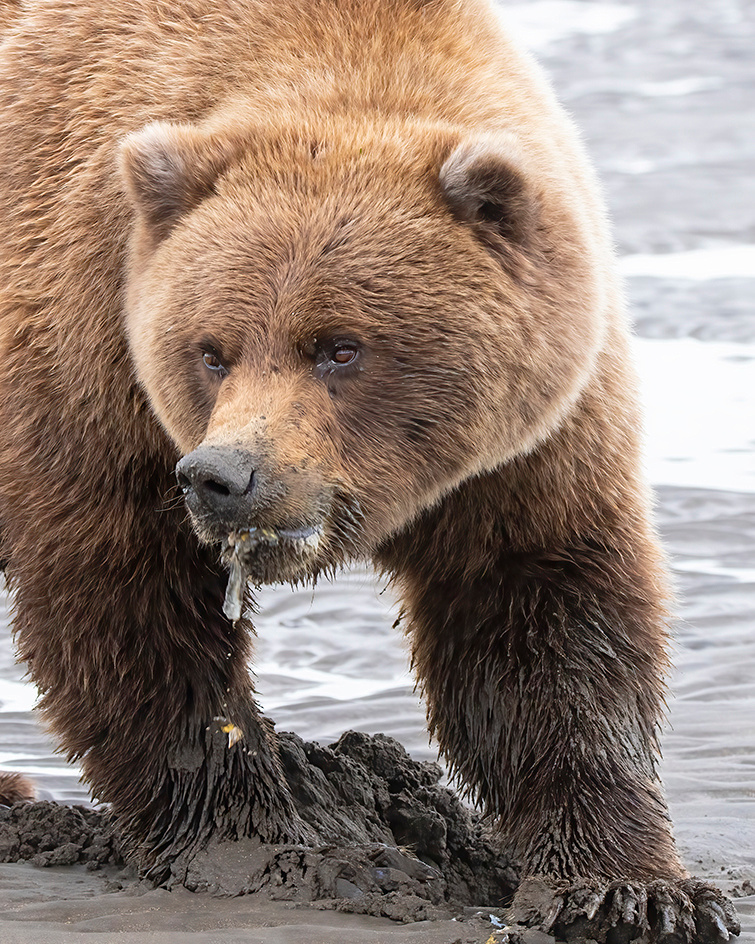

Digging up clams.
After a productive morning photo shoot we headed into the lodge for lunch at 1pm. The lodge employs a small staff including a chef and a baker. Both were excellent. We also met our hosts David and Joanne Coray. Very genuine and welcoming hosts. After lunch we opted to take a scenic coastal boat tour along the coast north of the lodge to Chisik Island and Bird Rock, a cliff nesting site for a variety of seabirds including puffins. We saw several horned puffins and a few common murres, but obtained no decent photos. Apparently we were several weeks behind the peak of nesting activity. I was able to photograph one of the two peregrine falcons perched on Bird Rock from the boat. Beautiful birds.
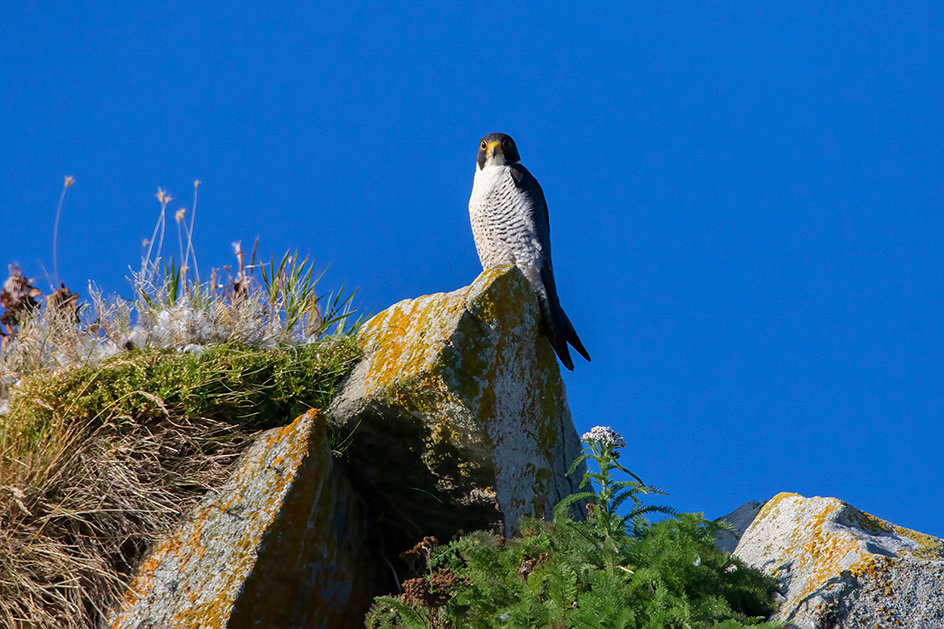

We saw little signs of human activity during the cruise. One rare exception was when we did cruise by an abandoned seafood cannery. We briefly landed on a stony beach to explore some bivalve fossil imprints and stretch our legs.


Abandoned seafood cannery.
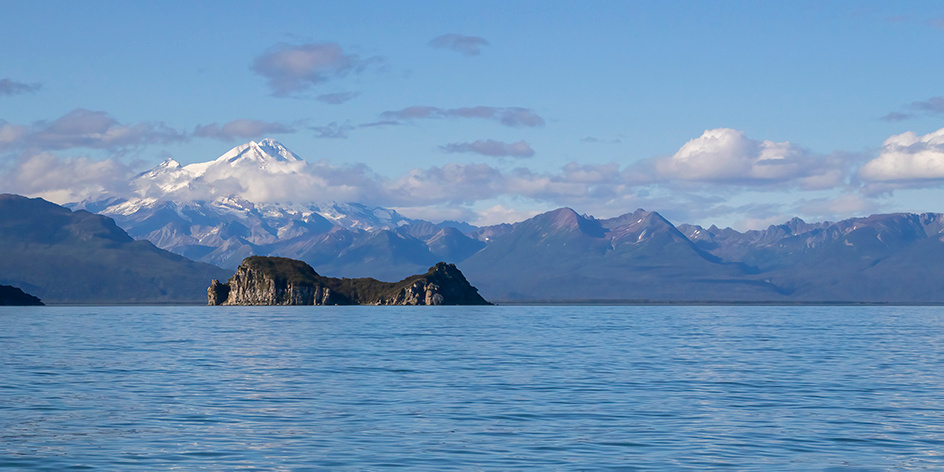
 Chigmit Mountains in the background and Chisik Island in the foreground.
Chigmit Mountains in the background and Chisik Island in the foreground.
We returned to the lodge in time for happy hour, a daily communal gathering in the Wheelhouse. We enjoyed Alaskan Amber Ale and wine with a friendly group of photographers. I was somewhat suprised that many within the group were repeat customers. One husband and wife duo were on their seventh or eighth visit.
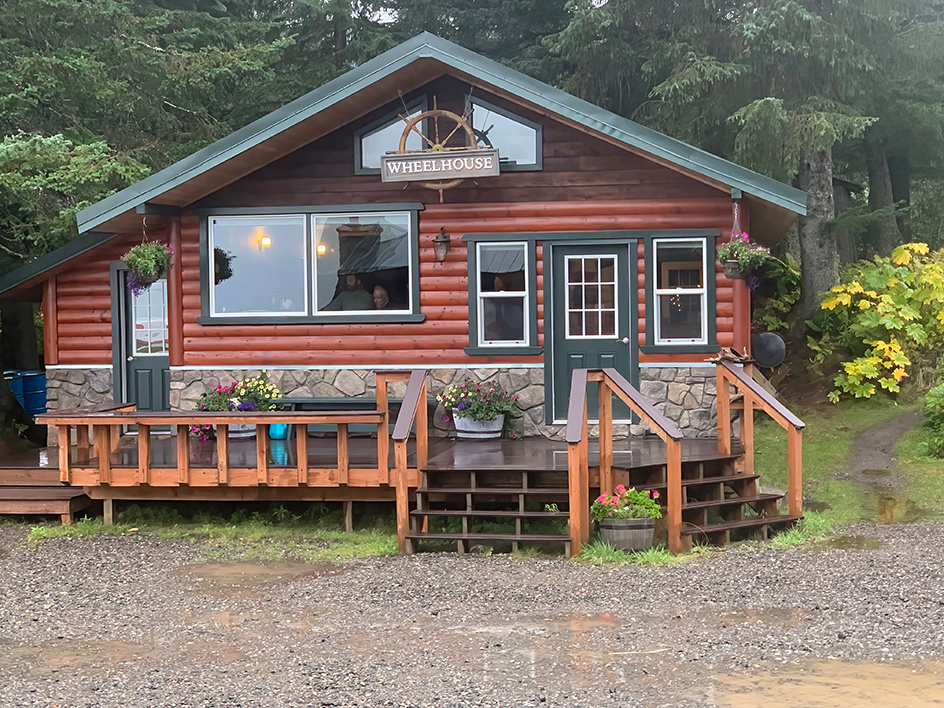

The Wheelhouse. Wifi and happy hour.
Silver Salmon Creek Lodge was originally a remote fishing lodge and still offers quality guided fishing for both salmon locally and within the Cook Inlet for halibut.
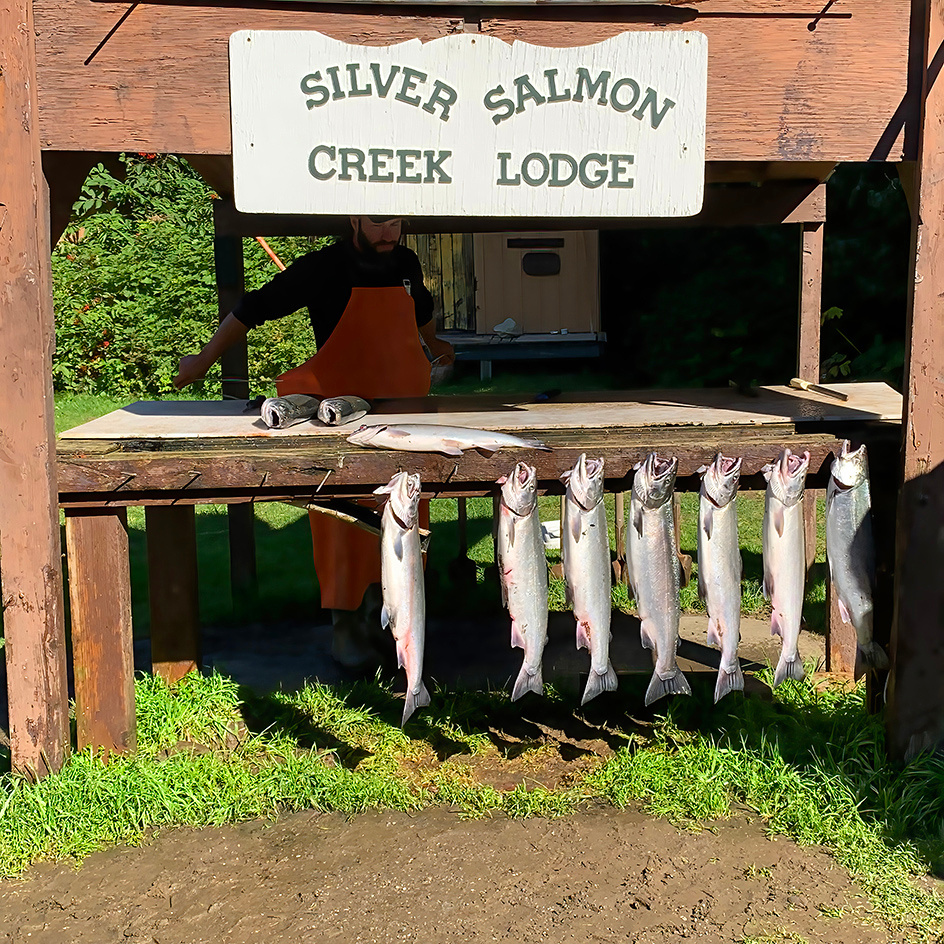

The daily catch.
I was quite excited that first evening to have 3 bears wandering around the lodge grounds during happy hour and dinner. This later proved to be a nightly occurrence. After dinner we retired to the Puffin Perch, our lodging. It was clean, cozy and comfortable.
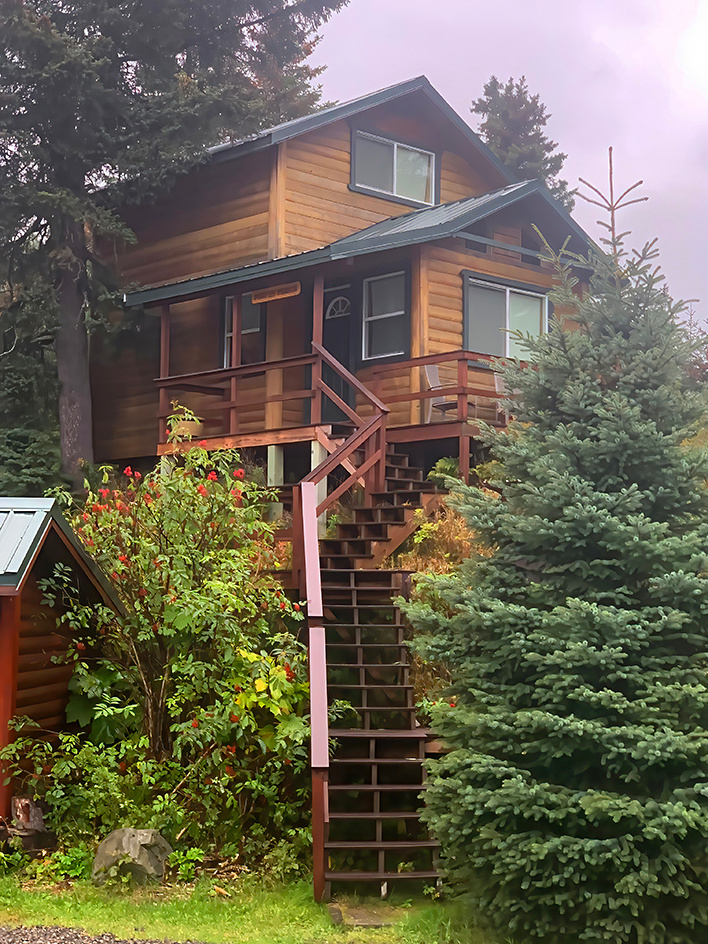

Puffin Perch. Our home for the week.
We headed out again the next morning about one-half hour before daylight to photograph bears with the background of the sunrise over the Kenai Range across the Cook Inlet. Cold traveling in the open carts well before sunrise. It was 36 degrees that morning. It was so worth it!




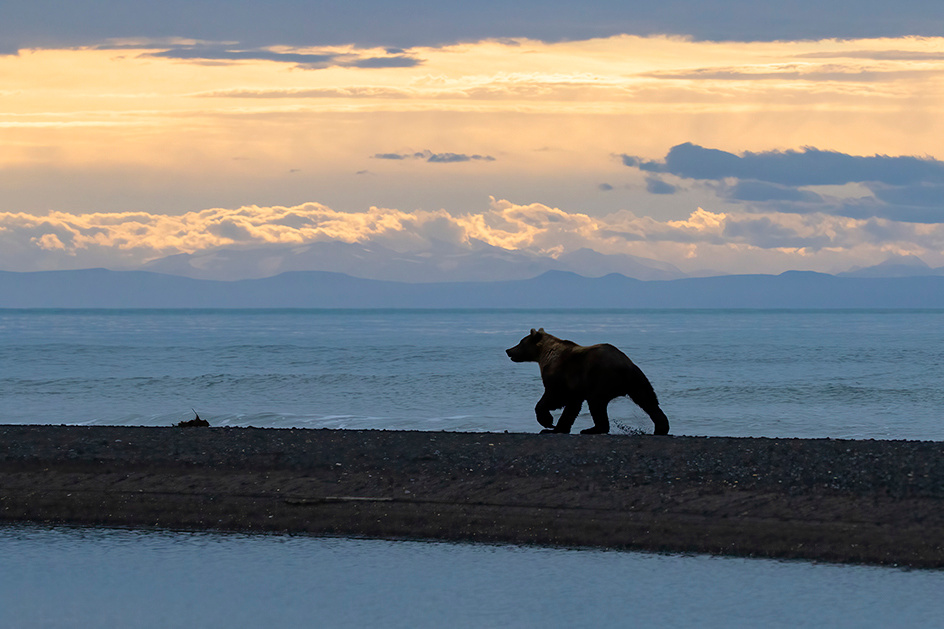

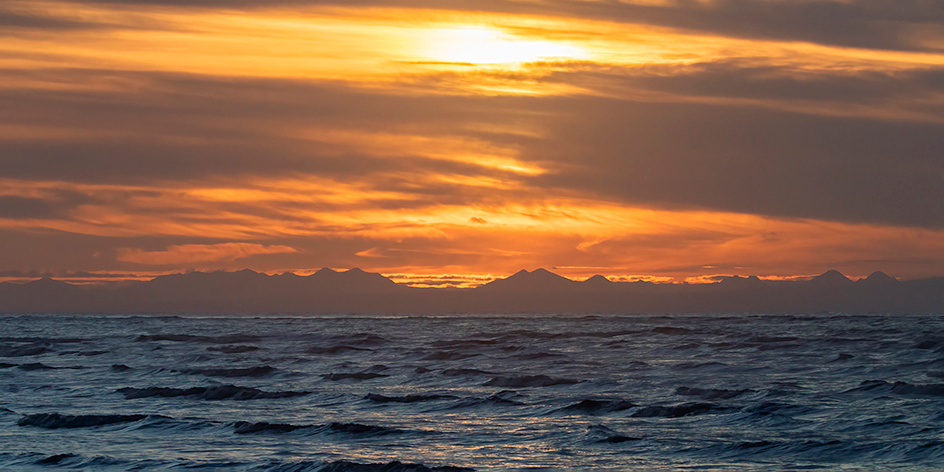

Even without a bear in the shot it was a stunning sunrise.
We headed back for an 8 am breakfast and then back to the bears. At breakfast they always posted the next days menu. Something to look forward to!


As is typical for Alaska, we had a variety of weather. It rained several days and was overcast most of the remainder. We had originally booked 6 days at the lodge hoping to only lose one or two due to weather. Many photographers who chose an overnight visit never saw the sun.


My bride and arctic explorer dressed for the weather. Seven layers on top, three on the bottom and still cold.
The rain and overcast conditions made for some challenging lighting for action photography, especially fishing bears. These guys can go from asleep to 30 mph in seconds if they detect a salmon attempting to push upstream. A camera with a high ISO/low noise capability is very beneficial to capture the action.
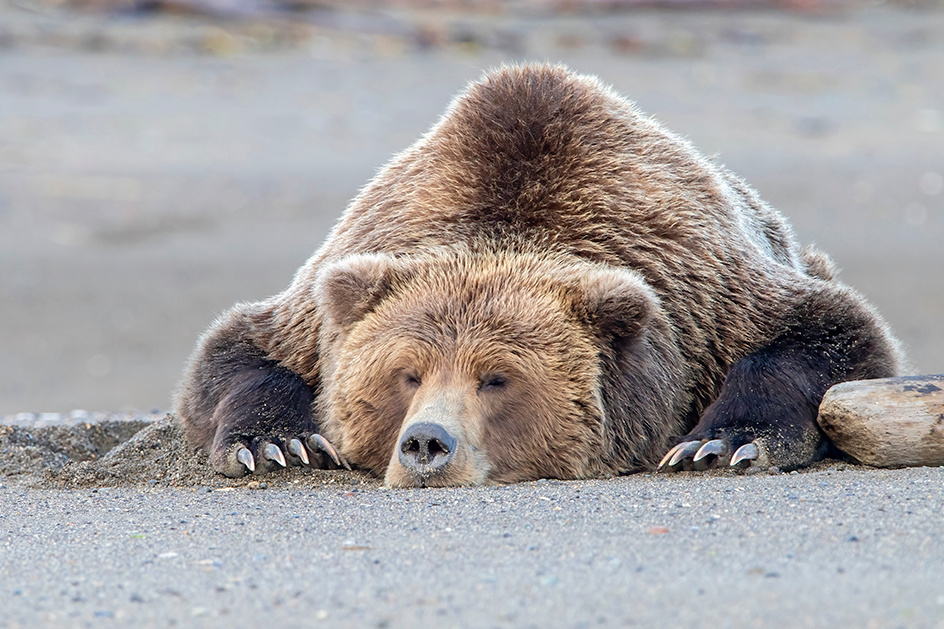

While she appears asleep, any unnatural splashing in the creek could bring her fully awake and focused.
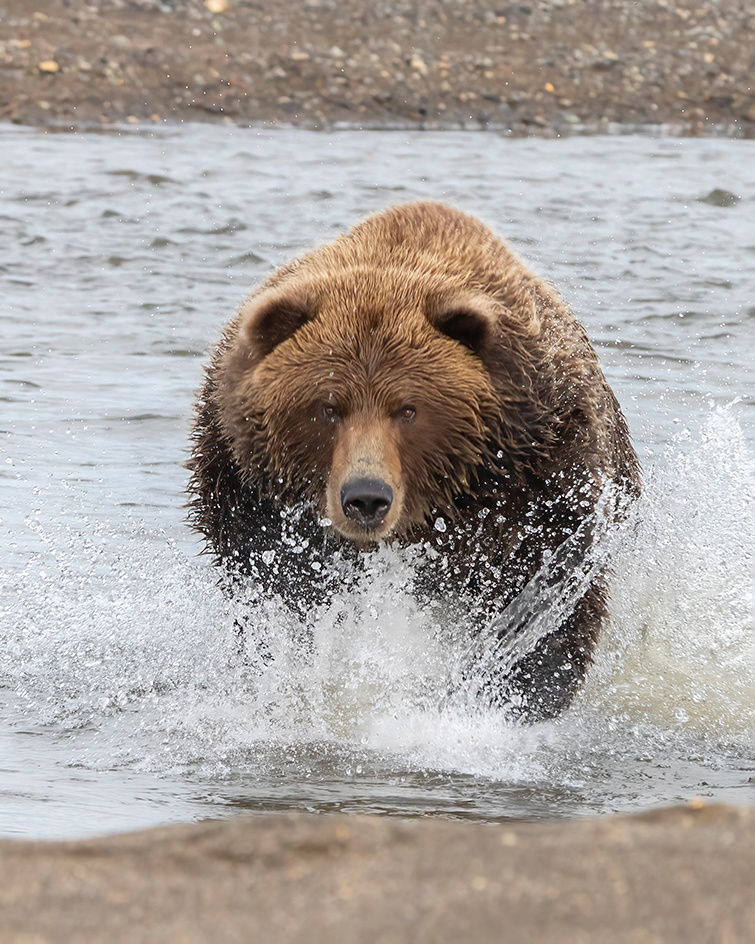

Chasing salmon.


And the capture.
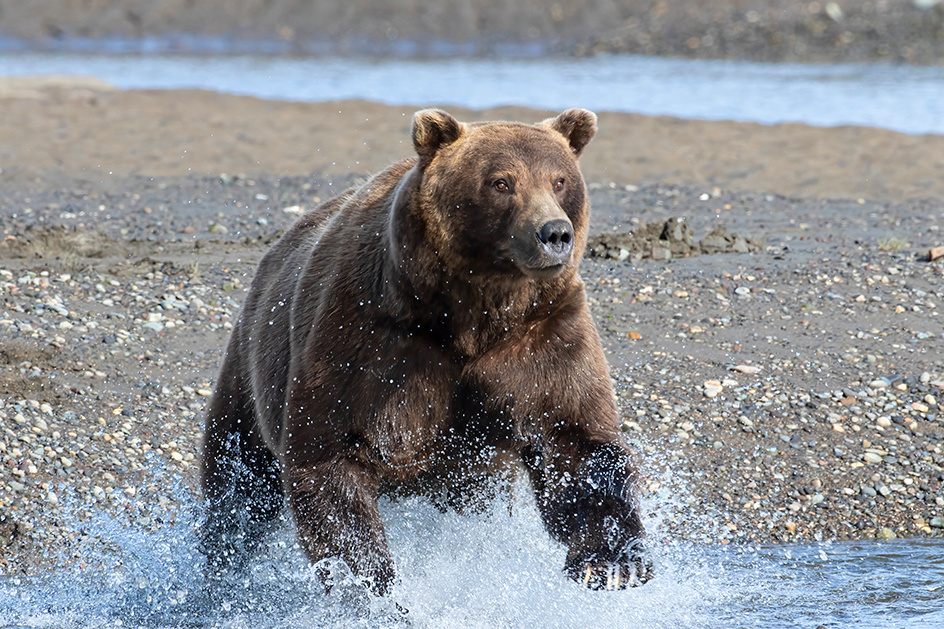

Large male chasing fish.
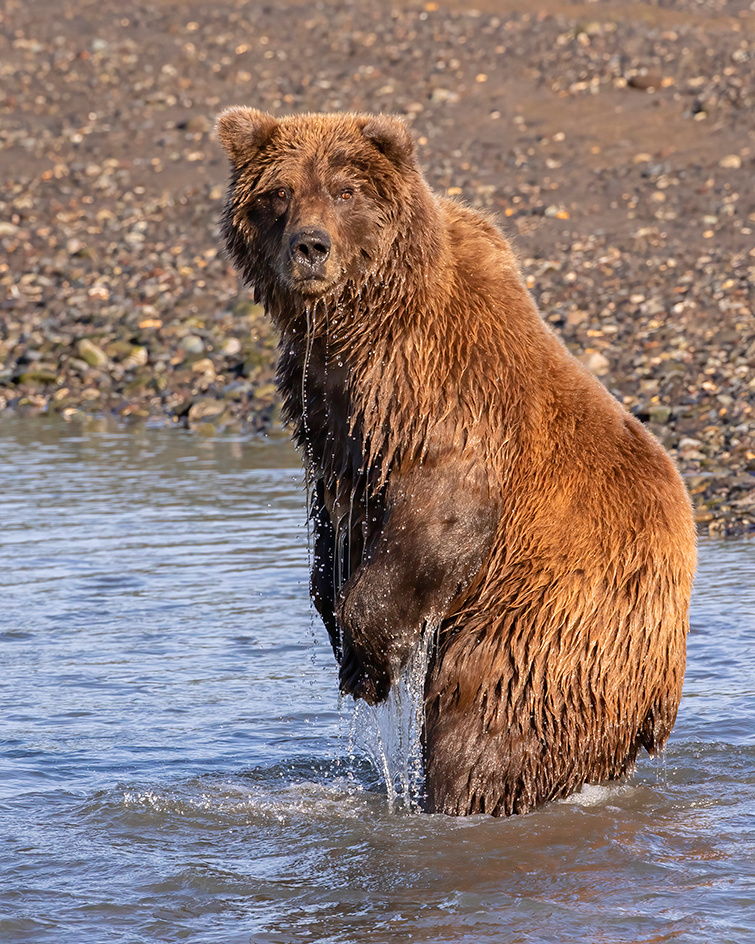

After a miss the bears would occasionally stand to get a better view in an attempt to reacquire the fleeing salmon.
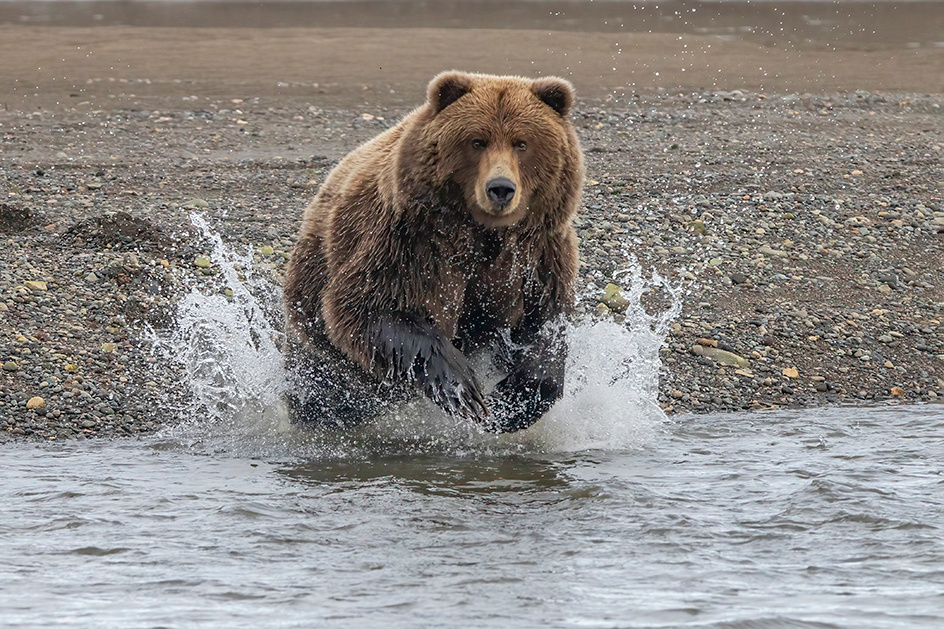

Raw speed and power.
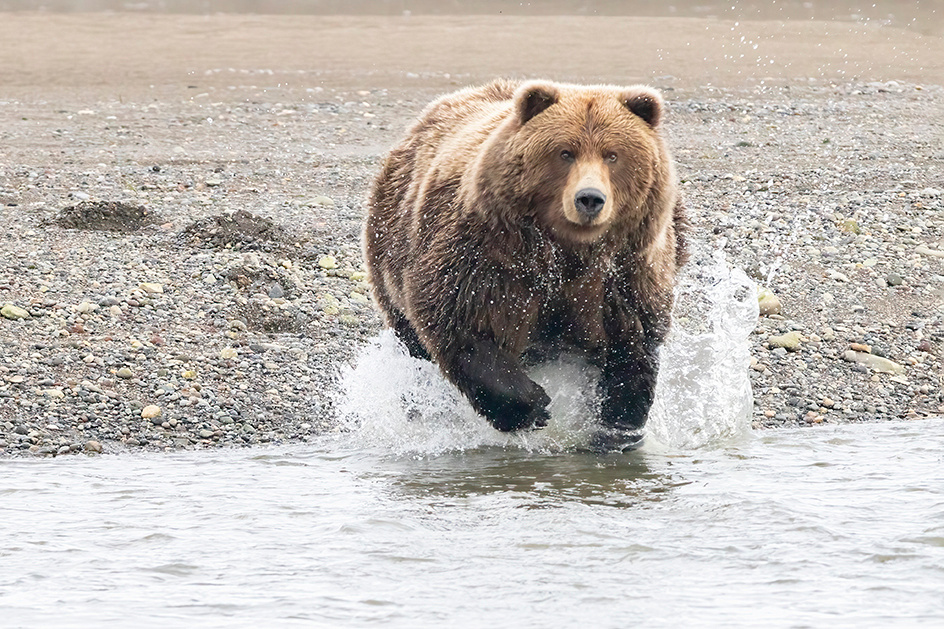

Love the eye contact.
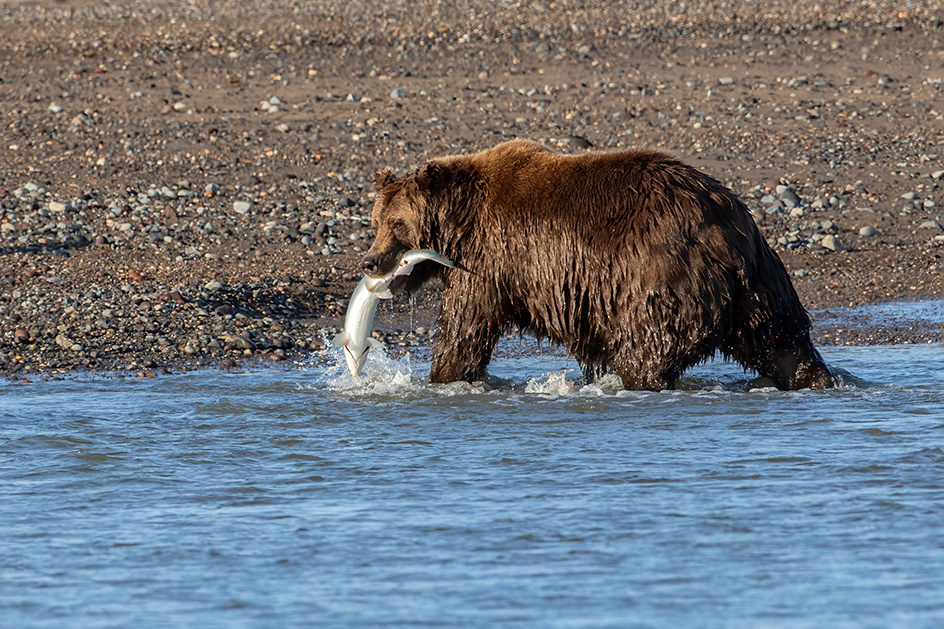

Another capture.
In addition to actively fishing for salmon, the bears were adept at scavenging. They walked the shoreline and frequently encountered dead fish including spiney dogfish (small sharks) and flounder. I suspect that these fish may have been discarded bycatch from offshore commercial fishing operations.
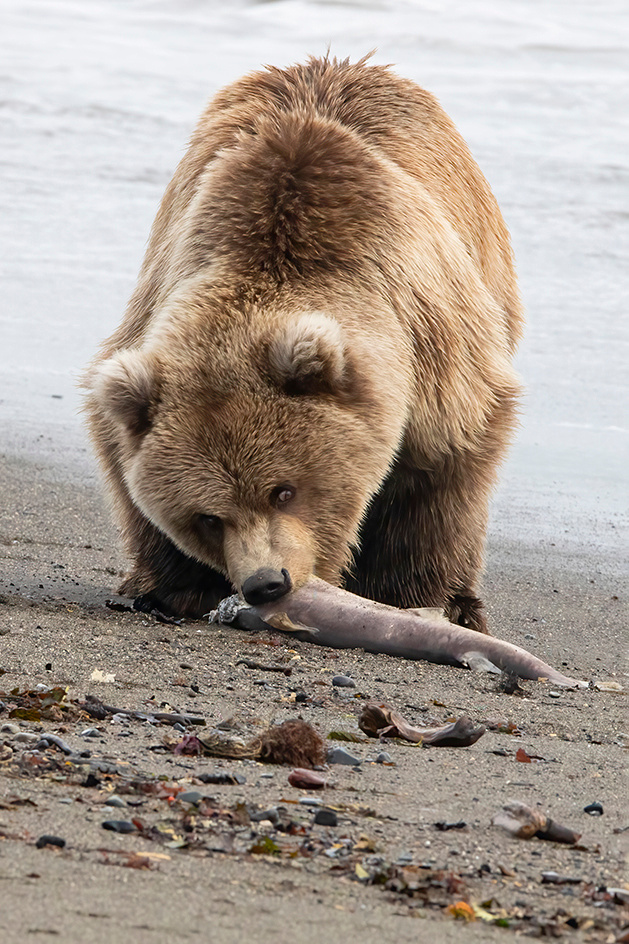

Cub eating a scavenged spiny dogfish.
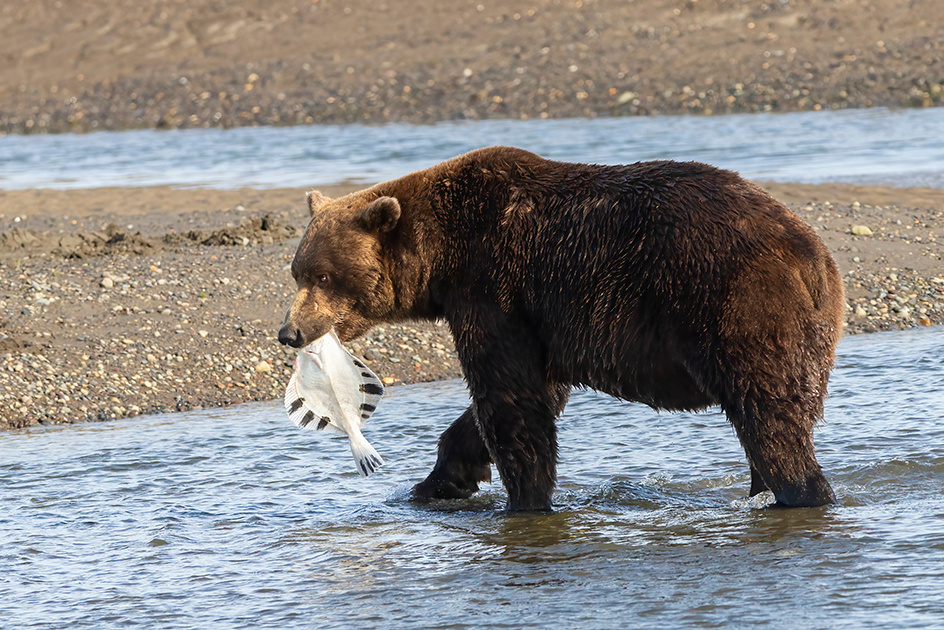

Young male with a scavenged flounder.
In addition to salmon, clamming, and scavenging, the bears spent many hours a day grazing on grasses and forbs. Beach pea, a legume, seemed to be a favorite at this time of year. They are reported to consume 30 pounds of vegetation per day and it is the mainstay of their diet as they emerge from hibernation.
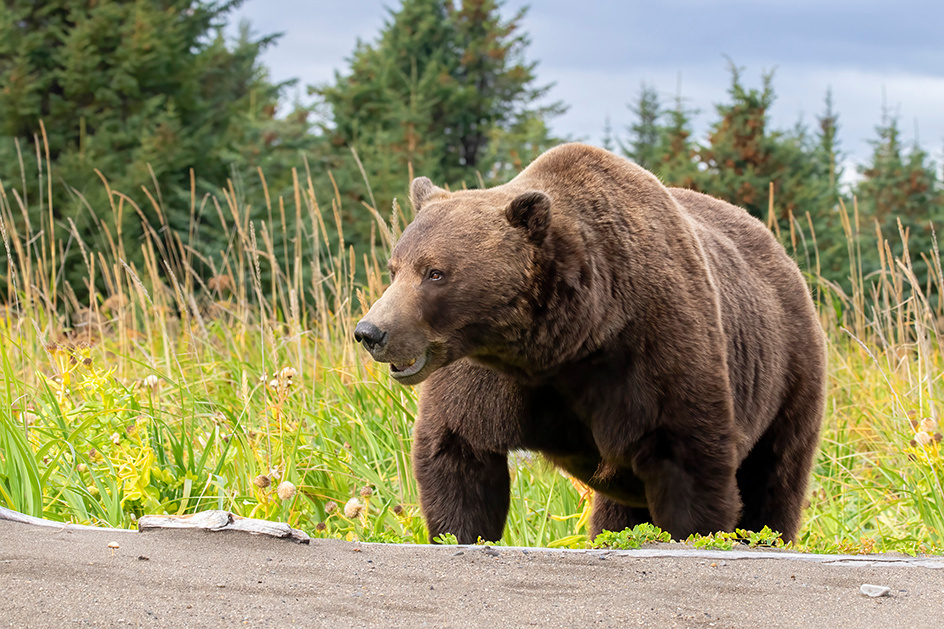

Medium to large adult male emerging from the forest.


Bear at the end of the rainbow.
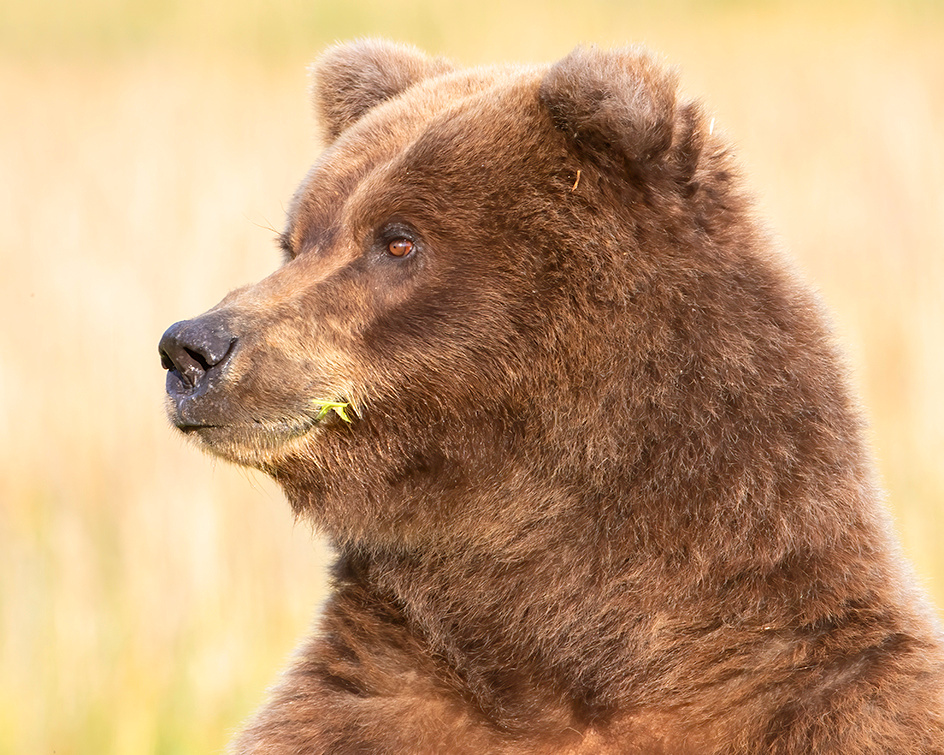

This bear stood and scanned the area in some rare nice light.
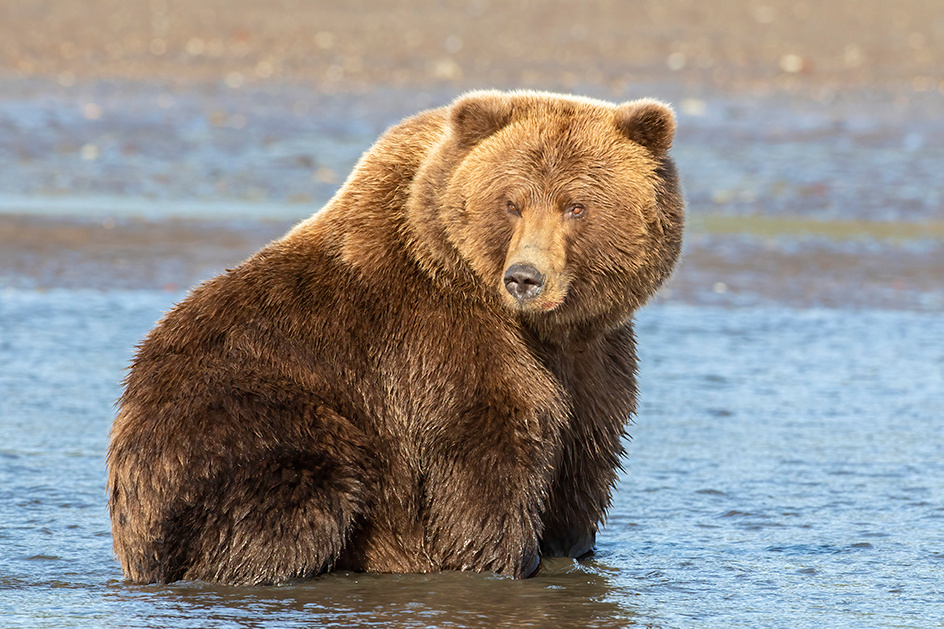
 The guides had named the bears. This is Aggro, a very heavy female. She had lost her cubs early in the season and was believed to be pregnant again at the time of this photo. These bears practice delayed implantation where the fertilized egg is not attached at the time of breeding, but rather months later during hibernation. The cubs are born blind, hairless, and softball-sized in the den during hibernation. They emerge from hibernation with their mother in June or July. June/July is probably the best time to photograph very small cubs and or breeding bears.
The guides had named the bears. This is Aggro, a very heavy female. She had lost her cubs early in the season and was believed to be pregnant again at the time of this photo. These bears practice delayed implantation where the fertilized egg is not attached at the time of breeding, but rather months later during hibernation. The cubs are born blind, hairless, and softball-sized in the den during hibernation. They emerge from hibernation with their mother in June or July. June/July is probably the best time to photograph very small cubs and or breeding bears.


This second-year cub was pestering his mom to nurse.
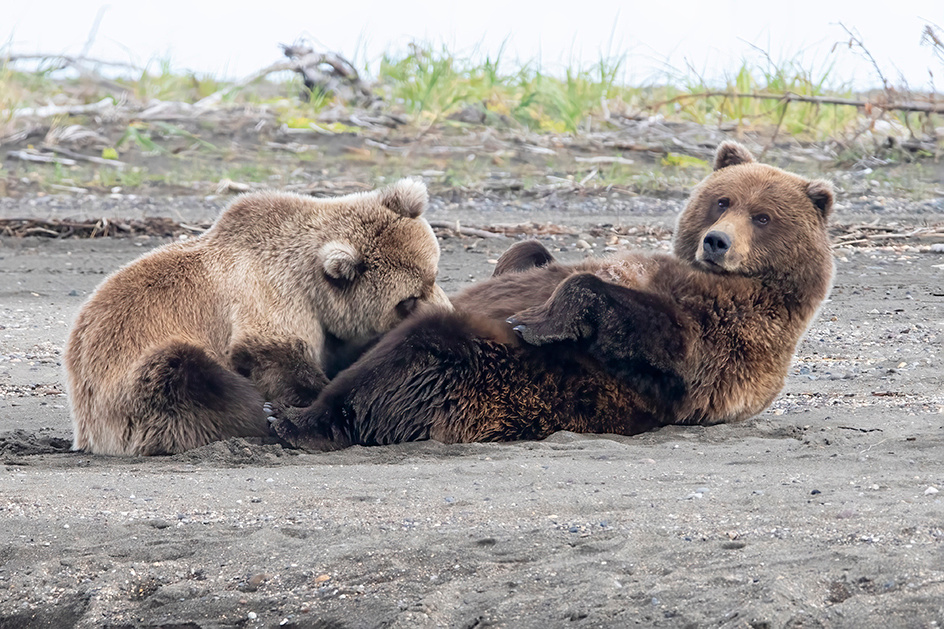

Nursing on the beach.
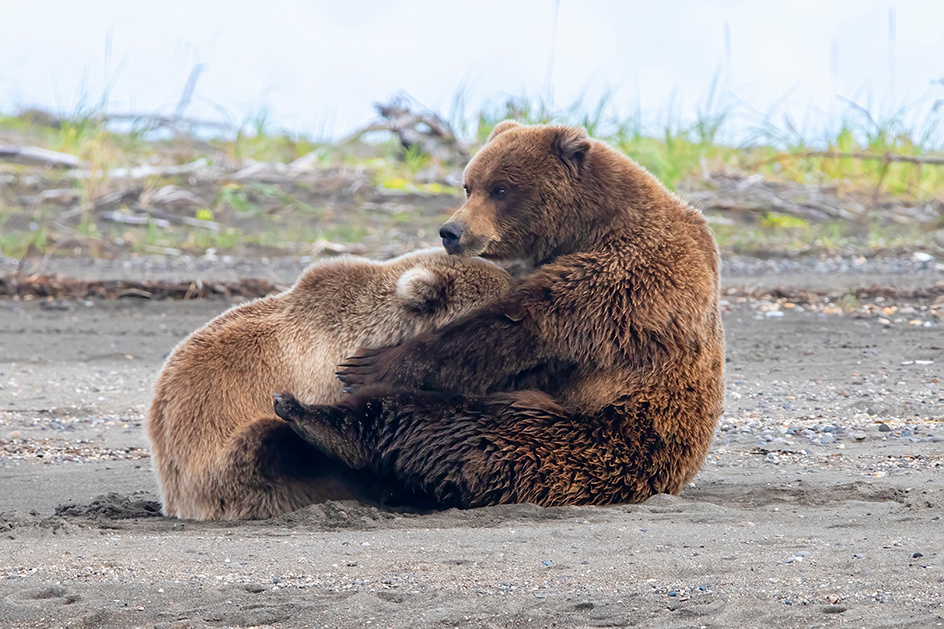



One very photogenic cub.
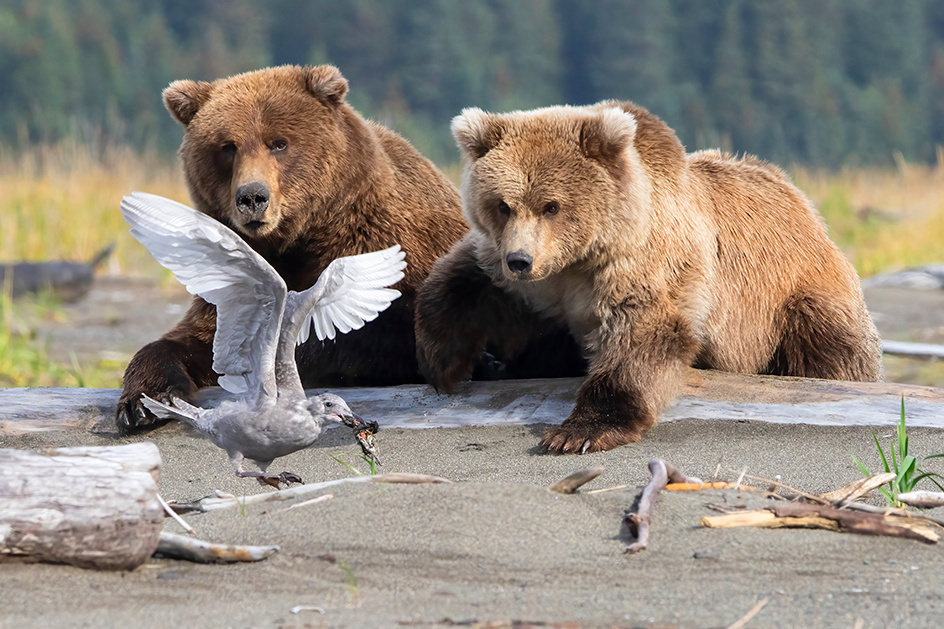

This gull got a little to close to these bears with a food morsel.
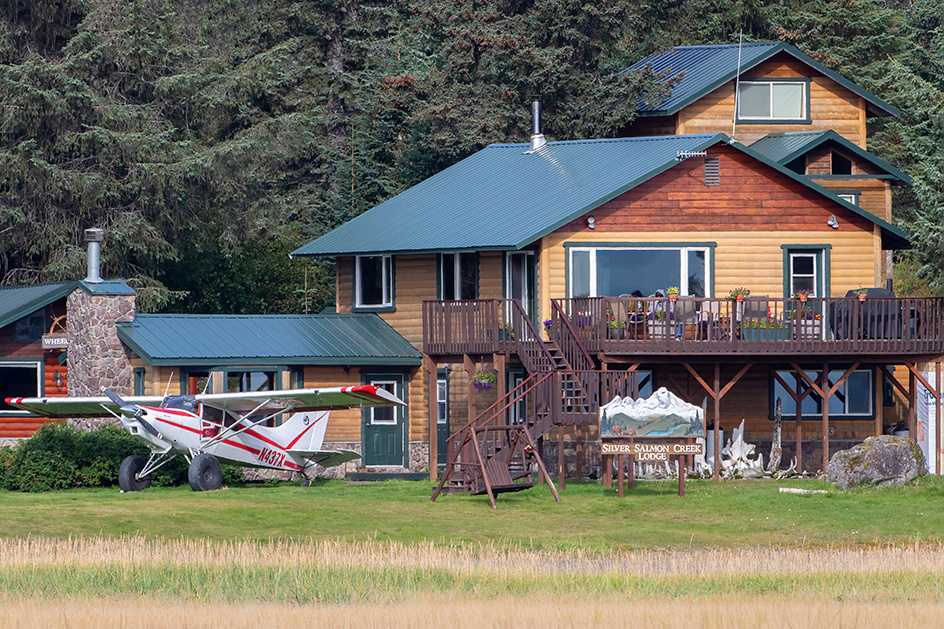
 Silver Salmon Creek Lodge can accommodate up to 28 visitors at a time. Several expert lead photo tour groups (6 to 8 individuals) went through the lodge while we were there. It is unclear what is gained by joining a photo group tour as the lodge guides are well versed in photographers wants and needs. In my opinion, little benefit would be provided to experienced photographers by an expert lead tour group at this location. The plane parked out front is owned by Oliver and is modified to allow very short take off distances (200-300 feet).
Silver Salmon Creek Lodge can accommodate up to 28 visitors at a time. Several expert lead photo tour groups (6 to 8 individuals) went through the lodge while we were there. It is unclear what is gained by joining a photo group tour as the lodge guides are well versed in photographers wants and needs. In my opinion, little benefit would be provided to experienced photographers by an expert lead tour group at this location. The plane parked out front is owned by Oliver and is modified to allow very short take off distances (200-300 feet).
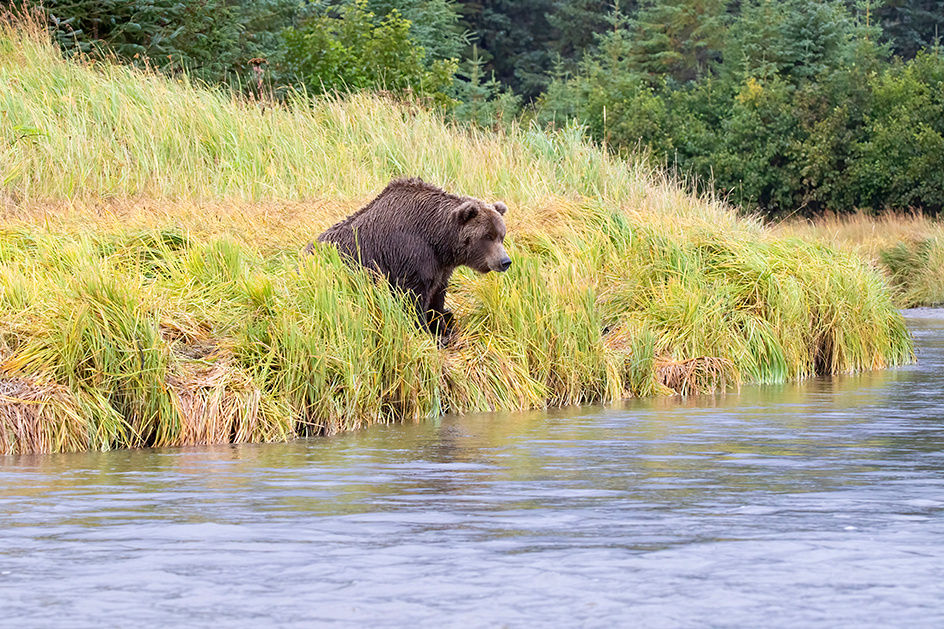

Fishing in the rain.
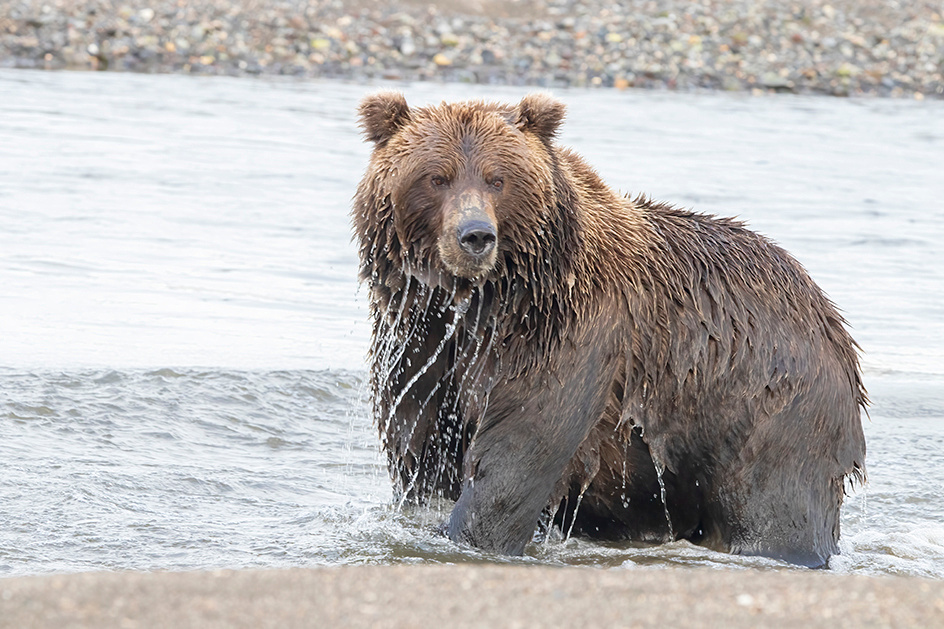
 Some bears used a snorkeling fishing technique where they submerge their head and scan for fish visually underwater.
Some bears used a snorkeling fishing technique where they submerge their head and scan for fish visually underwater.
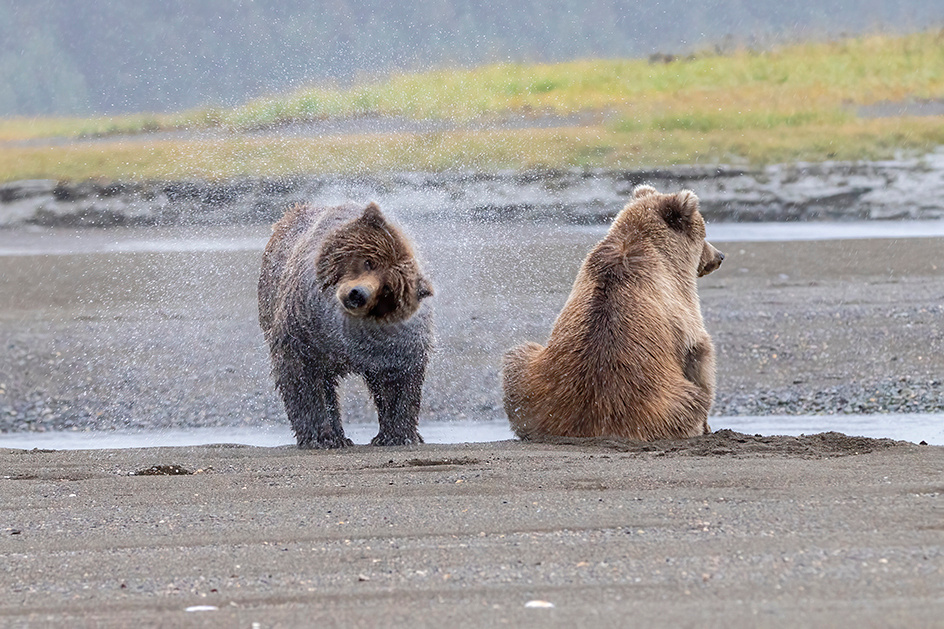
 Spin dry.
Spin dry.
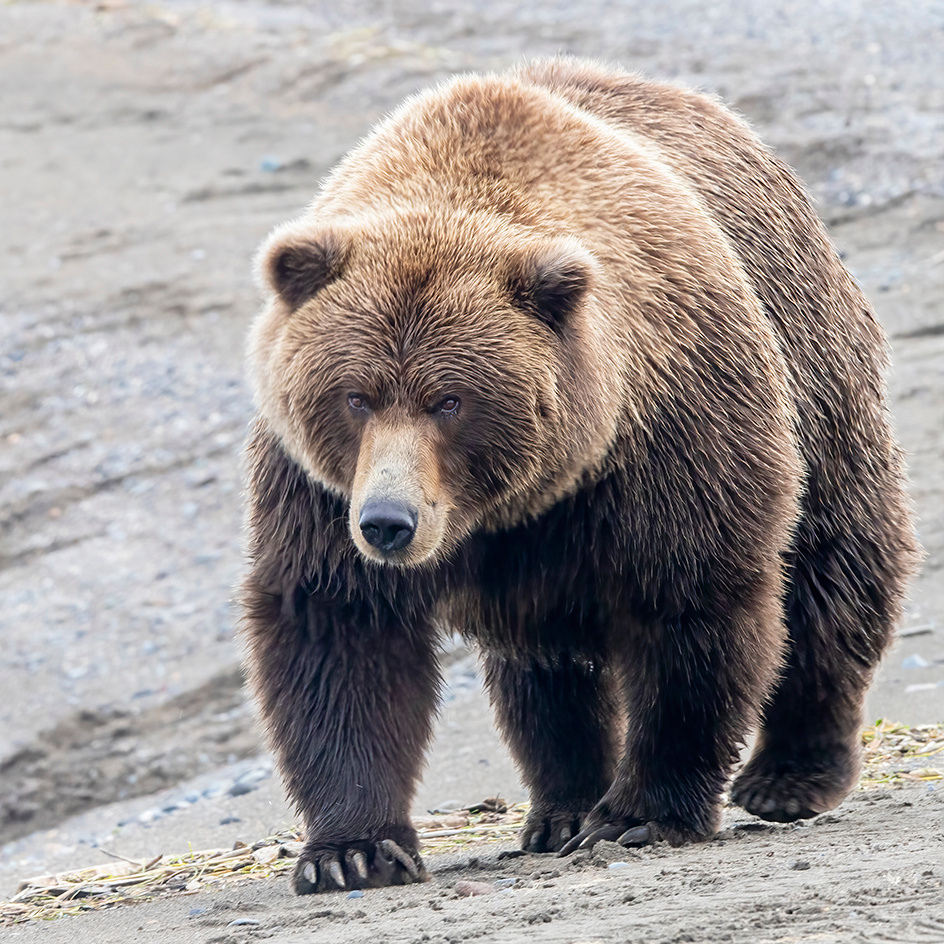

Frame filling shot of a large female.
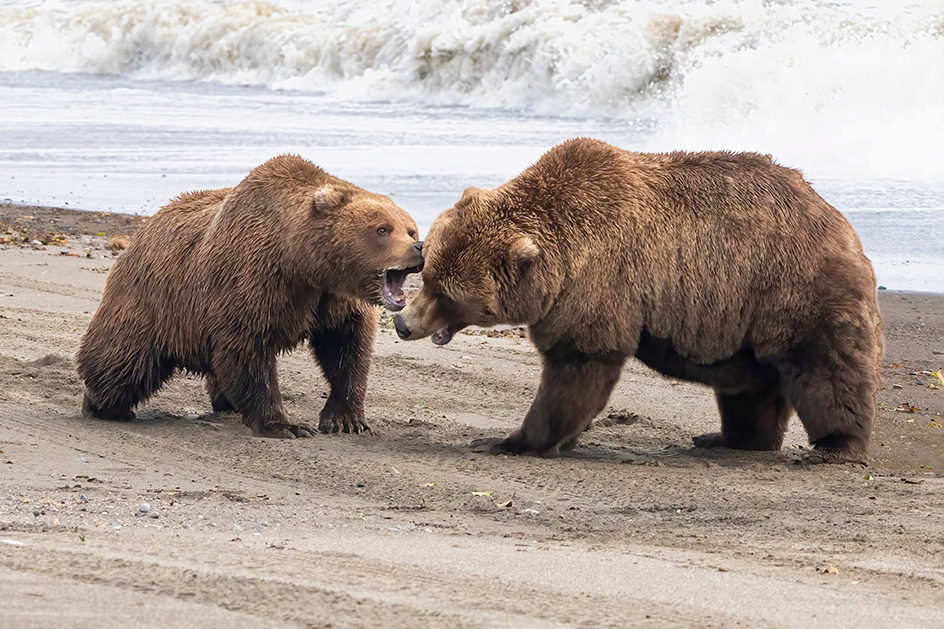
 The bears generally spaced themselves out in the environment. Interactions between bears were uncommon at this time of year. In this case, four fish had washed up on the beach and three bears came together at the same time and space. Some mouth to mouth threat displays and then both bears moved away from each other. At one point the next day, a female with cub was grazing within 100 yards of a medium to large male (named Cubkiller). He had apparently earned his name in front of a large group of photographers. She would periodically stand on her hind legs to see him over the grass to insure he was not moving toward the cub. So much interesting behavior.
The bears generally spaced themselves out in the environment. Interactions between bears were uncommon at this time of year. In this case, four fish had washed up on the beach and three bears came together at the same time and space. Some mouth to mouth threat displays and then both bears moved away from each other. At one point the next day, a female with cub was grazing within 100 yards of a medium to large male (named Cubkiller). He had apparently earned his name in front of a large group of photographers. She would periodically stand on her hind legs to see him over the grass to insure he was not moving toward the cub. So much interesting behavior.
Bird life was relatively uncommon. Glaucous-winged gulls, bald eagles and common mergansers were observed every day. Small passerines were almost completely absent. I did get two life birds on the trip (spruce grouse and horned puffin).
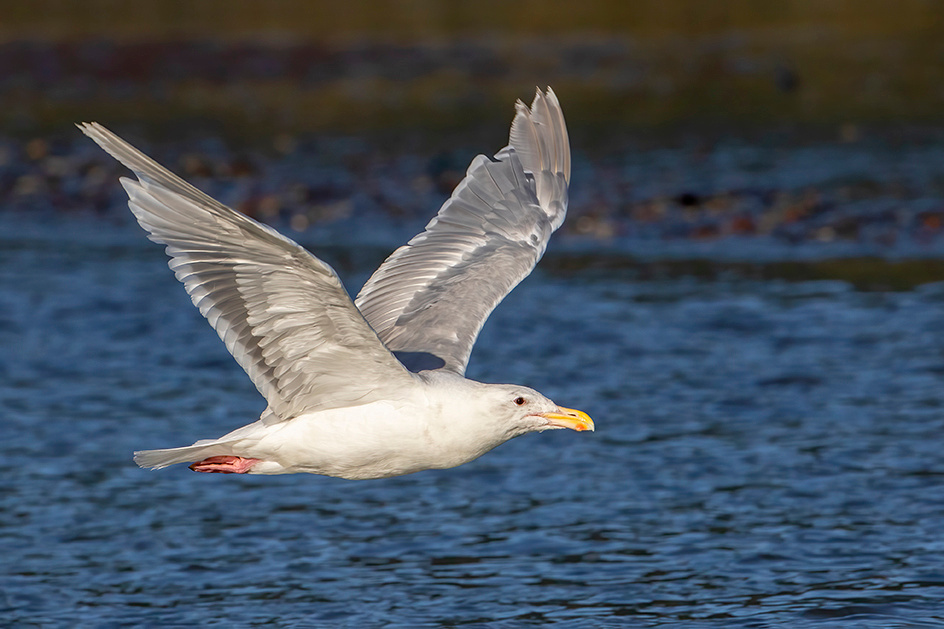
 Glaucous-winged gull.
Glaucous-winged gull.
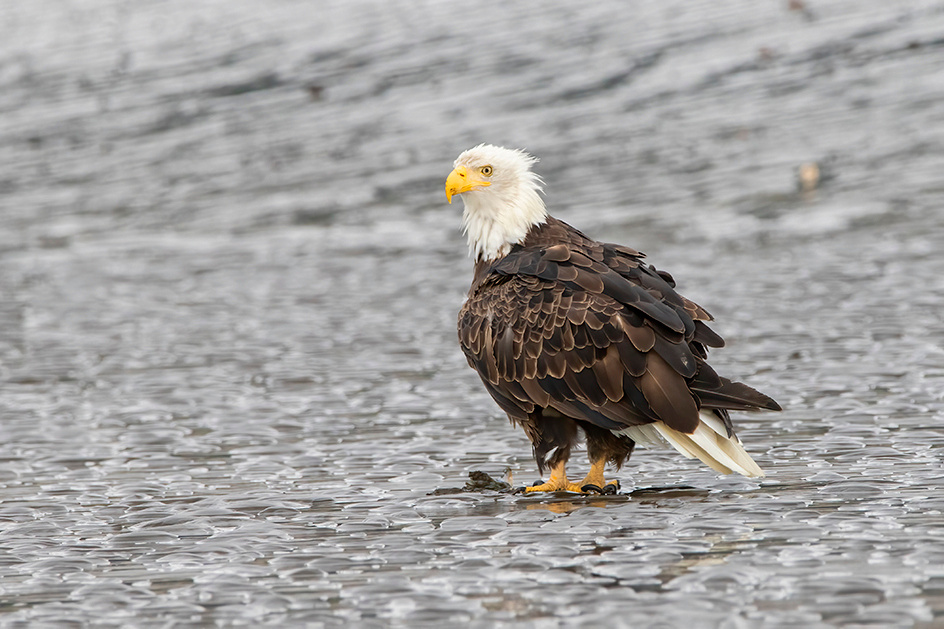
 Adult bald eagle at low tide.
Adult bald eagle at low tide.
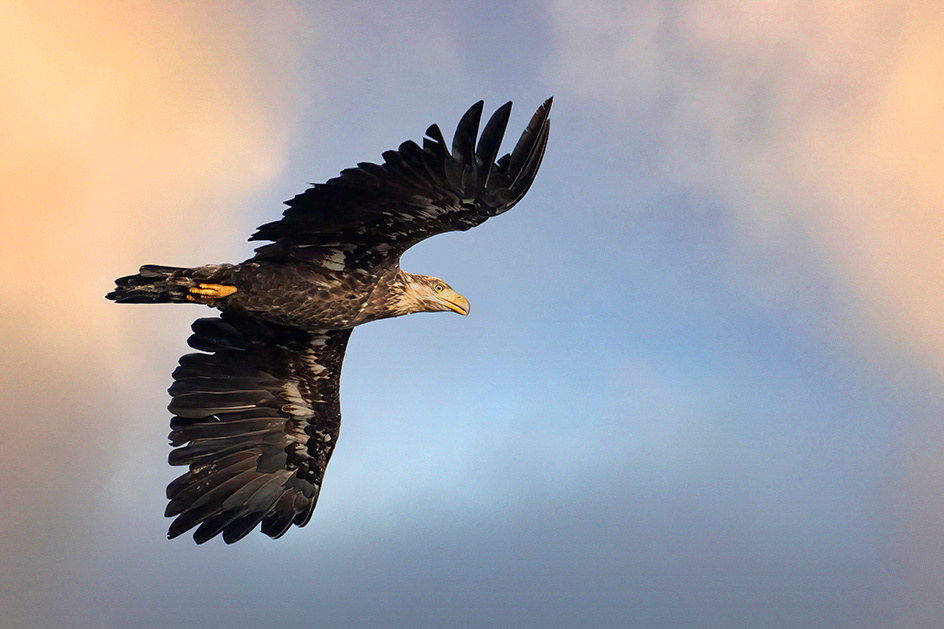
 Immature bald eagle. Just acquiring its adult plumage with the white head and tail.
Immature bald eagle. Just acquiring its adult plumage with the white head and tail.
Silver Salmon Creek Lodge is located in an area of incredible vast landscapes.
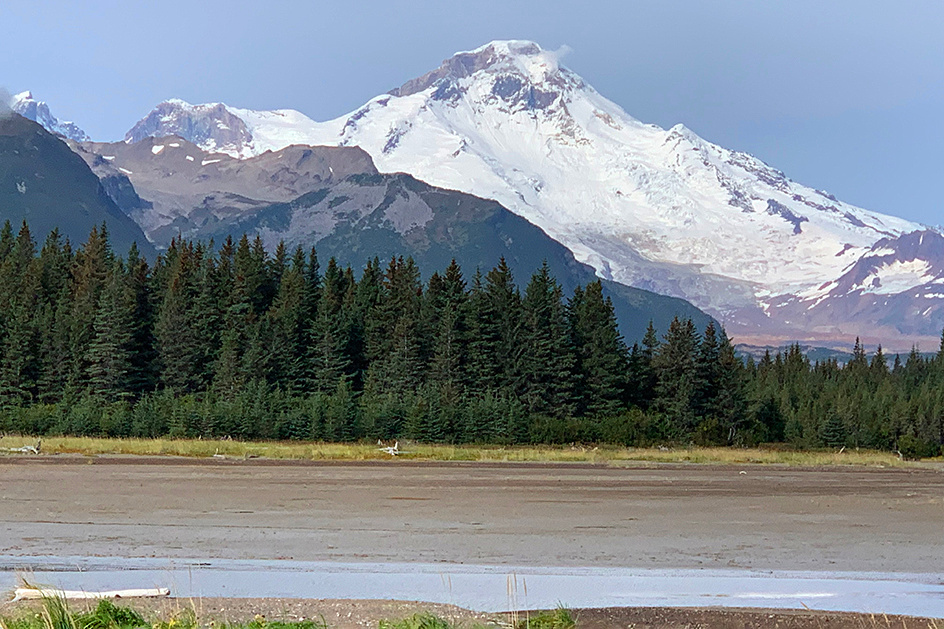
 Mount Iliamna. Note the volcanic steam plume near the summit on the right side.
Mount Iliamna. Note the volcanic steam plume near the summit on the right side.
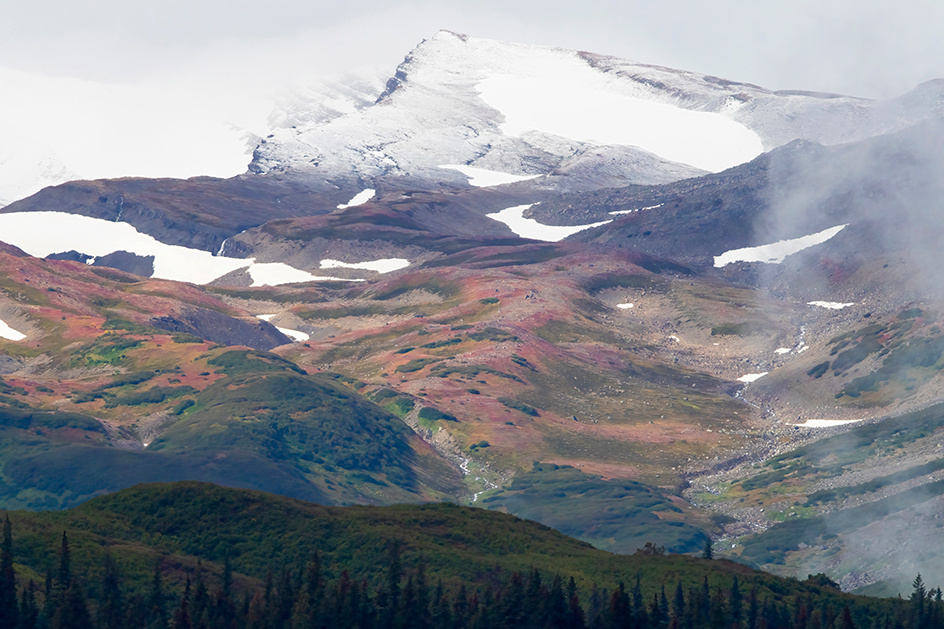
 View from the lodge.
View from the lodge.
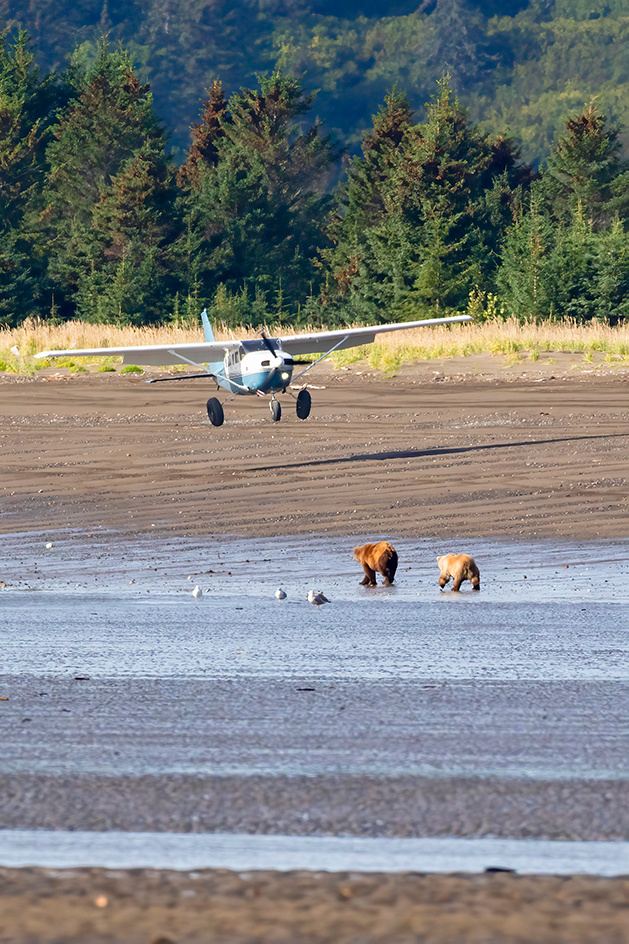

Logs washed up on the beach during storms and were a hazard to planes landing and taking off. Bears themselves could also pose a hazard to landings and take-offs. This pilot had to pull up and hop over these bears in order to land.
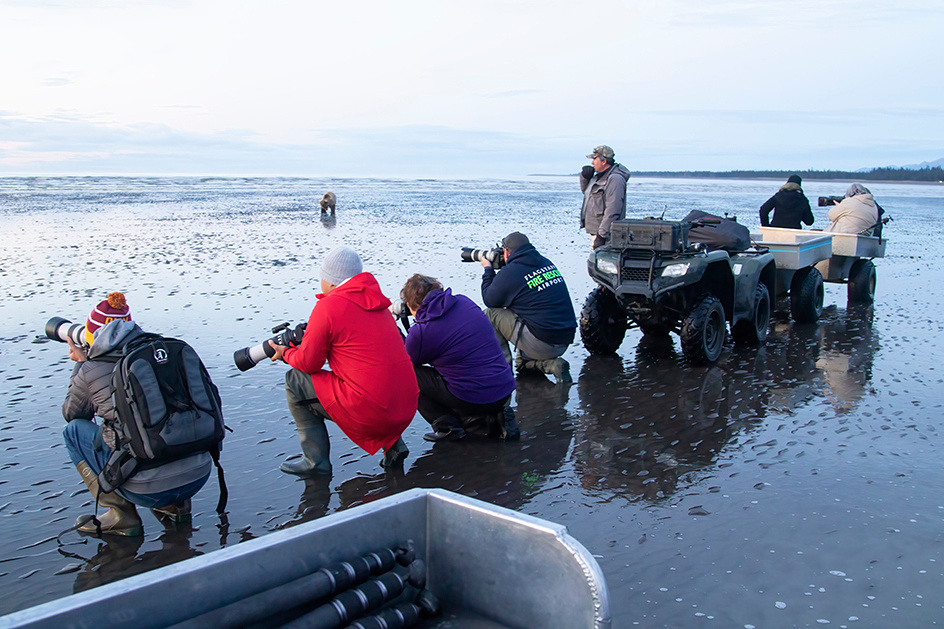
 Photographers lined up for the sunrise shoot.
Photographers lined up for the sunrise shoot.
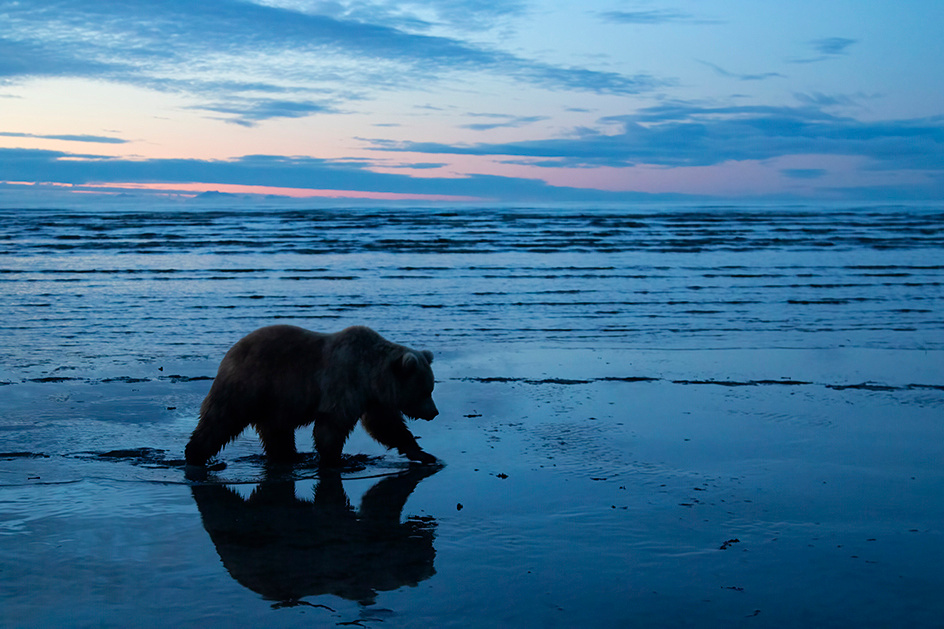
 Sunrise silhouette.
Sunrise silhouette.

 Apparently not ONLY in the woods!
Apparently not ONLY in the woods!
Rob, our guide, work very hard to get us the best images possible under existing conditions. Rob always seemed to be able to predict what the bears might do next and position us well for the shot. Even though occasionally bears were at less than minimum focus distance, I never felt unsafe. This proximity did take some getting used to in the beginning. All the staff at the lodge were friendly and accommodating.
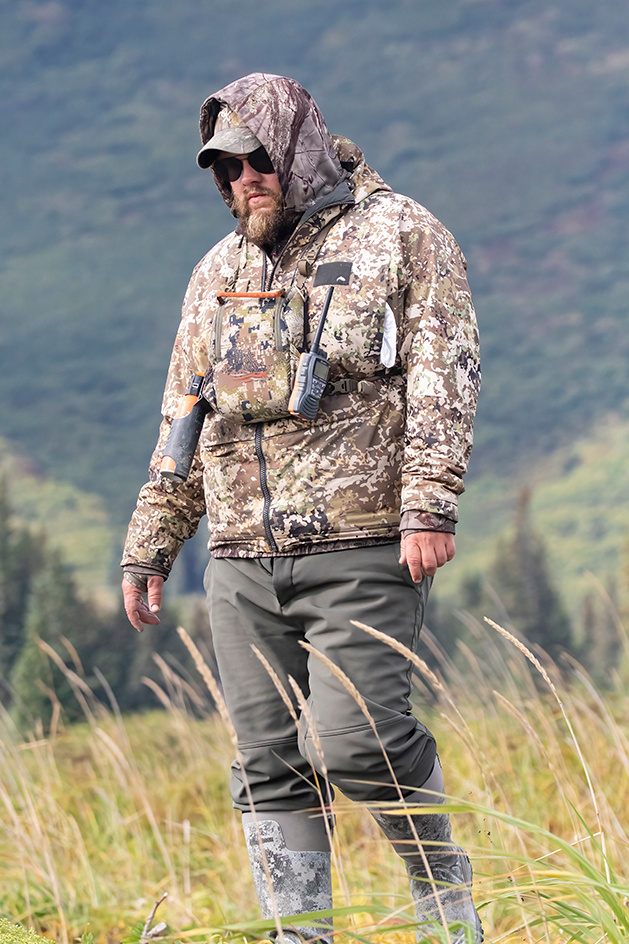

Rob.
I highly recommend Silver Salmon Creek Lodge as a coastal brown bear photo venue. Our flight out was delayed a day due to gusty winds, so planning a transport delay into your schedule might be prudent. Good raingear for yourself and your equipments are necessary. Lots of layers and waterproof gloves should be included when packing. Most photographers did not use a tripod. I did for most of my shots. I normally try not to exceed ISO 800 on my Canon 7D2. On this trip I was frequently at 1600 ISO and even 3200 ISO a few times. I used an aftermarket noise reduction program to reduce image noise. I ended up with over 9500 images.
The End.